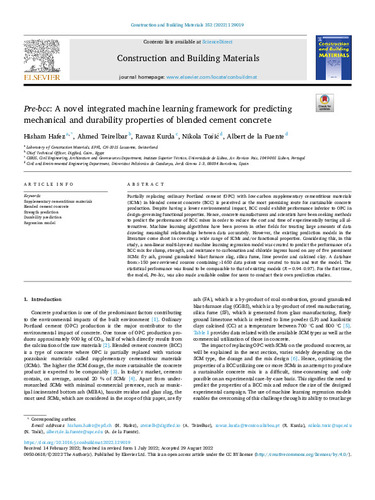Mostra el registre d'ítem simple
Pre-bcc: a novel integrated machine learning framework for predicting mechanical and durability properties of blended cement concrete
| dc.contributor.author | Hafez, H.S. |
| dc.contributor.author | Teirelbar, Ahmed |
| dc.contributor.author | Kurda, Reben |
| dc.contributor.author | Tošić, Nikola |
| dc.contributor.author | Fuente Antequera, Albert de la |
| dc.contributor.other | Universitat Politècnica de Catalunya. Departament d'Enginyeria Civil i Ambiental |
| dc.date.accessioned | 2022-09-13T10:44:13Z |
| dc.date.available | 2022-09-13T10:44:13Z |
| dc.date.issued | 2022-10 |
| dc.identifier.citation | Hafez, H. [et al.]. Pre-bcc: a novel integrated machine learning framework for predicting mechanical and durability properties of blended cement concrete. "Construction and building materials", Octubre 2022, vol. 352, p. 129019:1-129019:15. |
| dc.identifier.issn | 0950-0618 |
| dc.identifier.uri | http://hdl.handle.net/2117/372694 |
| dc.description.abstract | Partially replacing ordinary Portland cement (OPC) with low-carbon supplementary cementitious materials (SCMs) in blended cement concrete (BCC) is perceived as the most promising route for sustainable concrete production. Despite having a lower environmental impact, BCC could exhibit performance inferior to OPC in design-governing functional properties. Hence, concrete manufacturers and scientists have been seeking methods to predict the performance of BCC mixes in order to reduce the cost and time of experimentally testing all alternatives. Machine learning algorithms have been proven in other fields for treating large amounts of data drawing meaningful relationships between data accurately. However, the existing prediction models in the literature come short in covering a wide range of SCMs and/or functional properties. Considering this, in this study, a non-linear multi-layered machine learning regression model was created to predict the performance of a BCC mix for slump, strength, and resistance to carbonation and chloride ingress based on any of five prominent SCMs: fly ash, ground granulated blast furnace slag, silica fume, lime powder and calcined clay. A database from>150 peer-reviewed sources containing>1650 data points was created to train and test the model. The statistical performance was found to be comparable to that of existing models (R = 0.94–0.97). For the first time, the model, Pre-bcc, was also made available online for users to conduct their own prediction studies. |
| dc.language.iso | eng |
| dc.rights | Attribution 4.0 International |
| dc.rights.uri | http://creativecommons.org/licenses/by/4.0/ |
| dc.subject | Àrees temàtiques de la UPC::Enginyeria civil::Materials i estructures::Materials i estructures de formigó |
| dc.subject.lcsh | Concrete -- Testing |
| dc.subject.other | Supplementary cementitious materials |
| dc.subject.other | Blended cement concrete |
| dc.subject.other | Strength prediction |
| dc.subject.other | Durability prediction |
| dc.subject.other | Regression model |
| dc.title | Pre-bcc: a novel integrated machine learning framework for predicting mechanical and durability properties of blended cement concrete |
| dc.type | Article |
| dc.subject.lemac | Formigó -- Proves |
| dc.contributor.group | Universitat Politècnica de Catalunya. EC - Enginyeria de la Construcció |
| dc.identifier.doi | 10.1016/j.conbuildmat.2022.129019 |
| dc.description.peerreviewed | Peer Reviewed |
| dc.relation.publisherversion | https://www.sciencedirect.com/science/article/pii/S0950061822026745 |
| dc.rights.access | Open Access |
| local.identifier.drac | 34218697 |
| dc.description.version | Postprint (published version) |
| local.citation.author | Hafez, H.; Teirelbar, A.; Kurda, R.; Tosic, N.; de la Fuente, A. |
| local.citation.publicationName | Construction and building materials |
| local.citation.volume | 352 |
| local.citation.startingPage | 129019:1 |
| local.citation.endingPage | 129019:15 |
Fitxers d'aquest items
Aquest ítem apareix a les col·leccions següents
-
Articles de revista [3.008]
-
Articles de revista [340]


